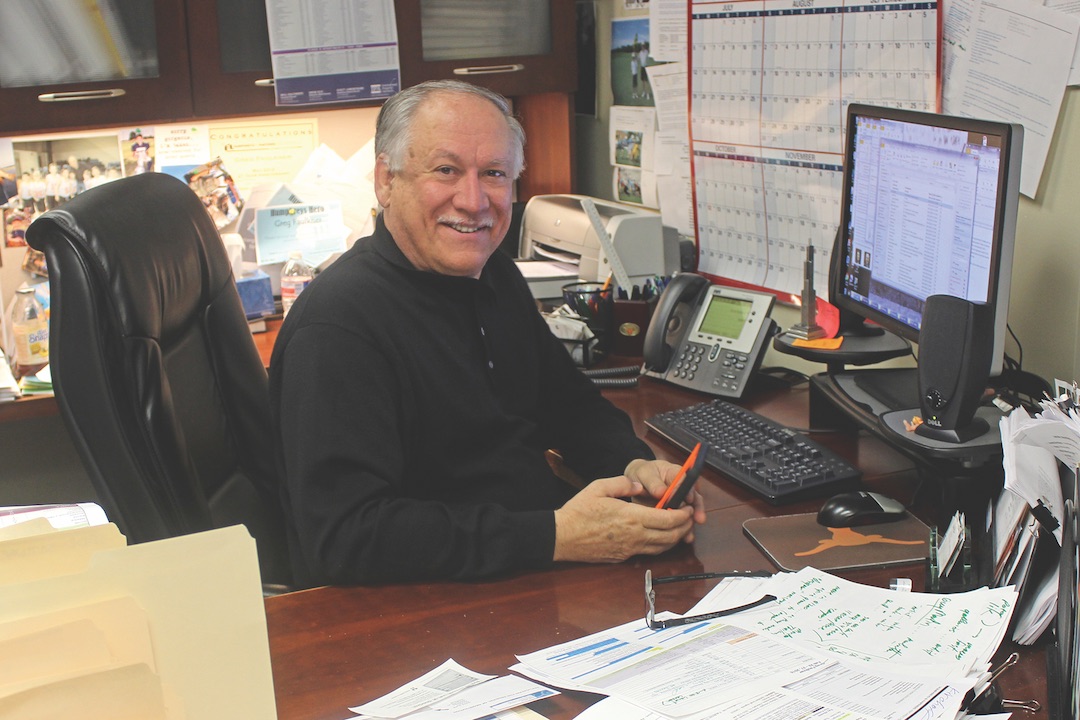Legend has it that Mark Humphreys won his first design award while still a student at Dallas’s W. T. White High School. The winning entry was a home he designed for a district-wide competition. As an architecture student at Texas Tech in the mid-1970s, he took a part-time job designing apartment buildings for a local developer in Lubbock. It didn’t take him long to figure out that he could do the same work on his own. Before you could say “Go Red Raiders,” he had a posse of other Texas Tech architecture students punching out residential designs for his own business.
After earning his architecture degree in 1978, Humphreys had stints at various firms in Lubbock before moving to Dallas in 1989. There he worked with Greg Faulkner, a University of Texas–trained architect who had experience working for a developer in Memphis. Two years later, in defiance of the horrific recession that was paralyzing the U.S. economy, they launched Humphreys & Partners Architects.
With the recession in full swing, 1991 was hardly the best time to roll out any business, no less an architecture firm. Skilled professionals were being laid off right and left; a whole generation of architects would be lost during this period. “There wasn’t much multifamily work at the time, so we started with a few single-family housing projects and built from there,” said Faulkner, HPA’s President.
Those lean years reinforced the importance of viewing each project as an opportunity to build long-term client relationships. “We don’t look at any client as a one-time client; we want to do their next 10 projects,” said Faulkner. “That’s really how we’ve grown the firm.”
See Also: The latest data in the multifamily ‘amenities war’
Market-rate apartments are HPA’s bread and butter. Its work ranges from low-rise suburban buildings to towering urban structures. About half of HPA projects also integrate mixed-use components, whether that’s a sandwich shop or a large-scale retail and entertainment component.
HPA, which reported $78.2 million in multifamily design fees in 2017, ranks as the nation’s largest multifamily design firm. CEO Humphreys estimates the firm designs 12–15% of all apartments built in the U.S. That would represent more than 50,000 units last year.
POWERED BY ENTREPRENEURSHIP
The entrepreneurial spirit is deeply embedded in HPA’s culture. This force has guided the development of a half-dozen trademarked “signature designs” that improve the performance and efficiency of multifamily projects.
Humphreys devised the first of these innovations in 1995. “Big House” is a two-story apartment structure that combines elements of a townhouse and a single-family home, including direct-access garages and private entrances. Because the structure looks more like an upscale single-family home than a typical apartment building, the concept been welcomed in many suburban residential neighborhoods. HPA has designed more than 300 Big House projects throughout the U.S.
HPA introduced the “e-Urban” concept in 2007, in response to skyrocketing construction costs. The design replaces the long hallways of mid-rise apartment buildings with short corridors and elevators, delivering an efficiency ratio of more than 80%, compared to about 60% for typical mid-rise designs. It’s also less expensive to build.
Although multifamily work accounts for about 80% of HPA’s current portfolio, the firm also has significant experience in student residential, senior housing, and hospitality projects.
HPA approaches each project with a developer’s mindset. The firm focuses on the factors that help boost net operating income, such as location, walkability, proximity to parks and marketplaces, and attractive streetscapes. “We’re not just drawing up plans; we really engage with our clients to understand all of the economic factors of a project,” said Faulkner.
To help its clients position their businesses for the future, the firm hosts periodic online webinars and conducts ongoing research to identify demographic, lifestyle, and industry trends. “Anticipating needs is one of the things our clients appreciate most about us, because it contributes to a higher return on investment,” said Humphreys.

HPA Co-founder Greg Faulkner
AN EVER-EXPANDING FOOTPRINT
Strong global demand for multifamily units has fueled a period of unprecedented growth for HPA. “Over the last eight to 10 years, multifamily rental housing has been the center of the universe, and we’ve been riding that wave,” said Faulkner.
Humphreys and Faulkner have never been shy about their growth ambitions. Geographic expansion began in 1998 with the opening of an office in Orlando, Fla. HPA established a West Coast presence in 2005 in Newport Beach, Calif. The firm has grown its U.S. footprint to include offices in Charlotte, Chicago, Denver, Houston, Los Angeles, New Orleans, New York, and Scottsdale, Ariz.
Outside the U.S., HPA has expanded into regions with pent-up multifamily demand. Montevideo, Uruguay, was the site of the first international office, in 2011. The firm now operates a global network with additional offices in Chennai (India), Hanoi and Ho Chi Minh City (Vietnam), and London.
‘We’re not just drawing up plans. We really engage with our clients to understand all the economic factors of a project.’
—Greg Faulkner, AIA, NCARB
Demographic shifts, including downsizing Baby Boomers and Millennials who are drawn to high-density areas, continue to drive market demand for rental units. Those trends have helped grow the number of full-time HPA employees to 342, a 95% increase in employment over the last five years. “We don’t turn down work. We hire people, create jobs, and grow the company,” said Humphreys.
To distinguish the firm as an employer of choice in the current tight labor market, HPA positions itself as an energetic culture that encourages creativity and innovation, but with a strong business sense. “We’re not running an art gallery; we’re running a profit center—and we’re proud to share those profits with our employees,” said Faulkner.
The founders—both of whom are AIA and NCARB members—are committed to nurturing the next generation of architects at their respective alma maters. In 2015, Humphreys donated $1.5 million to Texas Tech University College of Architecture—the college’s largest one-time gift—to establish the Mark E. Humphreys AIA Chair in Urban Design. This endowed faculty position supports ongoing research in sustainable, engaged models of urban design. Faulkner has been instrumental in establishing two academic scholarships at the University of Texas at Austin School of Architecture.
BROADENING THE FIRM’S EXPERTISE
HPA has expanded its in-house expertise by establishing several complementary business units: HPA Design Group, an interiors practice; HPLA, a landscape architecture studio; HP Urban, which specializes in planning and design for high-density projects; HP Civil Engineering; and Atticus Real Estate, the company’s real estate investment and development arm.
Two other HPA businesses fall squarely outside the domain of a traditional design firm. Glass Recycled Surfaces, a manufacturing company that Humphreys purchased in 2013, repurposes glass bottles and porcelain fixtures into countertops, flooring, and wall applications. PiaggioCharter.com offers private air transportation, leasing, and charter services from its base at Addison Airport in suburban Dallas. The business is a deeply personal passion for Humphreys, whose father was a lead designer on the original Lear Jet Model 23. Humphreys earned his pilot’s license in 2007.
At times, HPA has ventured even further from its multifamily base to flex its design chops. Vice President of Design Walter Hughes recently conceptualized two urban skyports for electric-powered vertical take-off and landing aircraft (commonly known as eVTOLs). Last May, HPA’s concept was named one of six finalists at the second annual Uber Elevate Summit. “We’re always searching out new ways to expand the connective tissue between our multifamily residences and emerging disruptive technologies,” said Humphreys.
HPA’s founders are grateful for their success. “Twenty years ago, Mark and I would’ve cut off our right arms to be doing everything we’re doing right now,” said Faulkner. “We need to knock on wood every day because we’ve been very, very fortunate.”
Related Stories
MFPRO+ News | Jun 3, 2024
Seattle mayor wants to scale back energy code to spur more housing construction
Seattle’s mayor recently proposed that the city scale back a scheduled revamping of its building energy code to help boost housing production. The proposal would halt an update to the city’s multifamily and commercial building energy code that is scheduled to take effect later this year.
Resiliency | Jun 3, 2024
Houston’s buyout program has prevented flood damage but many more homes at risk
Recent flooding in Houston has increased focus on a 30-year-old program to buy out some of the area’s most vulnerable homes. Storms dropped 23 inches of rain on parts of southeast Texas, leading to thousands of homes being flooded in low-lying neighborhoods around Houston.
MFPRO+ New Projects | May 29, 2024
Two San Francisco multifamily high rises install onsite water recycling systems
Two high-rise apartment buildings in San Francisco have installed onsite water recycling systems that will reuse a total of 3.9 million gallons of wastewater annually. The recycled water will be used for toilet flushing, cooling towers, and landscape irrigation to significantly reduce water usage in both buildings.
MFPRO+ News | May 28, 2024
ENERGY STAR NextGen Certification for New Homes and Apartments launched
The U.S. Environmental Protection Agency recently launched ENERGY STAR NextGen Certified Homes and Apartments, a voluntary certification program for new residential buildings. The program will increase national energy and emissions savings by accelerating the building industry’s adoption of advanced, energy-efficient technologies, according to an EPA news release.
MFPRO+ News | May 24, 2024
Austin, Texas, outlaws windowless bedrooms
Austin, Texas will no longer allow developers to build windowless bedrooms. For at least two decades, the city had permitted developers to build thousands of windowless bedrooms.
Mass Timber | May 22, 2024
3 mass timber architecture innovations
As mass timber construction evolves from the first decade of projects, we're finding an increasing variety of mass timber solutions. Here are three primary examples.
Mixed-Use | May 22, 2024
Multifamily properties above ground-floor grocers continue to see positive rental premiums
Optimizing land usage is becoming an even bigger priority for developers. In some city centers, many large grocery stores sprawl across valuable land.
MFPRO+ News | May 21, 2024
Massachusetts governor launches advocacy group to push for more housing
Massachusetts’ Gov. Maura Healey and Lt. Gov. Kim Driscoll have taken the unusual step of setting up a nonprofit to advocate for pro-housing efforts at the local level. One Commonwealth Inc., will work to provide political and financial support for local housing initiatives, a key pillar of the governor’s agenda.
MFPRO+ News | May 21, 2024
Baker Barrios Architects announces new leadership roles for multifamily, healthcare design
Baker Barrios Architects announced two new additions to its leadership: Chris Powers, RA, AIA, NCARB, EDAC, as Associate Principal and Director (Healthcare); and Mark Kluemper, AIA, NCARB, as Associate Principal and Technical Director (Multifamily).
MFPRO+ News | May 20, 2024
Florida condo market roiled by structural safety standards law
A Florida law enacted after the Surfside condo tower collapse is causing turmoil in the condominium market. The law, which requires buildings to meet certain structural safety standards, is forcing condo associations to assess hefty fees to make repairs on older properties. In some cases, the cost per unit runs into six figures.

















